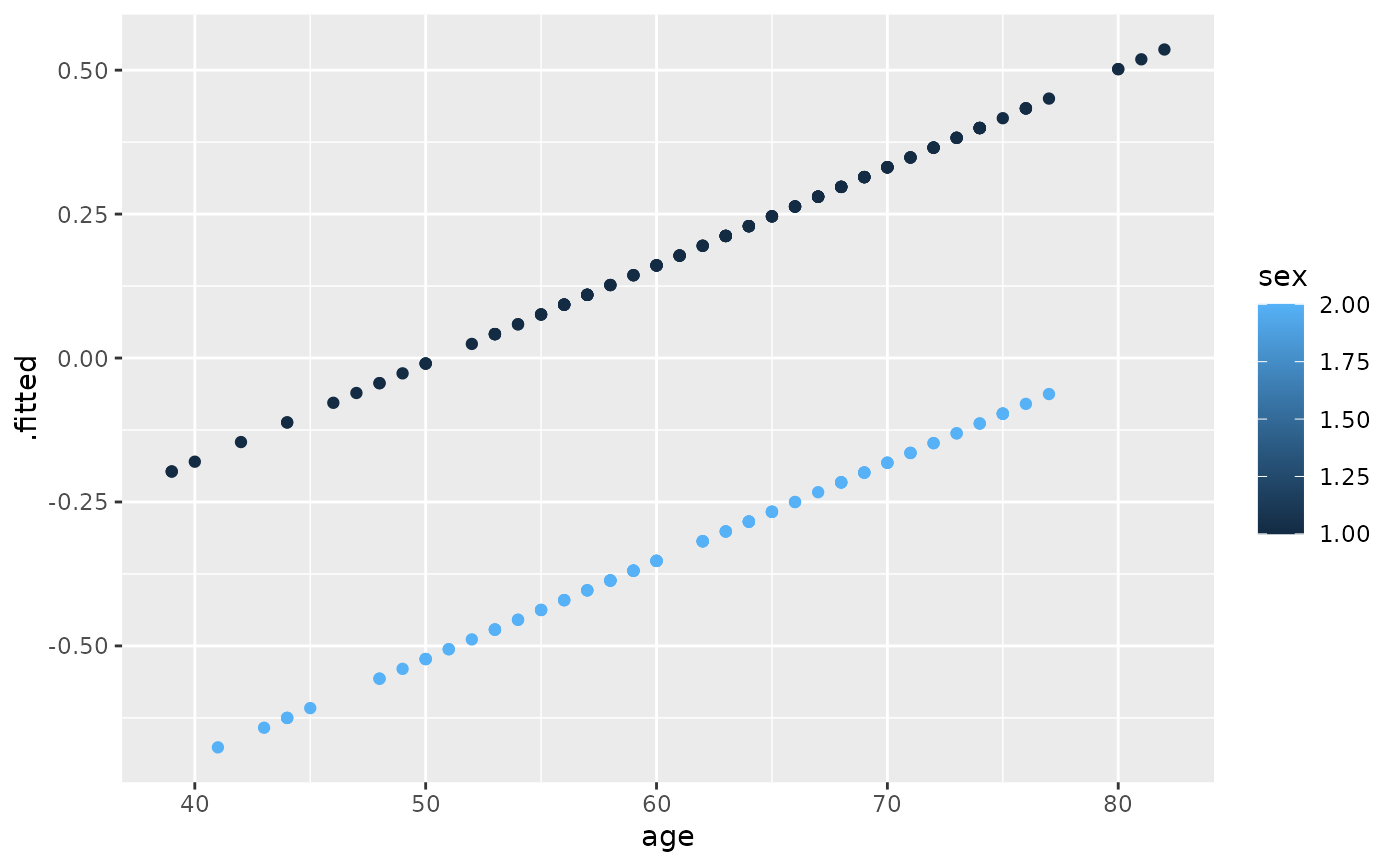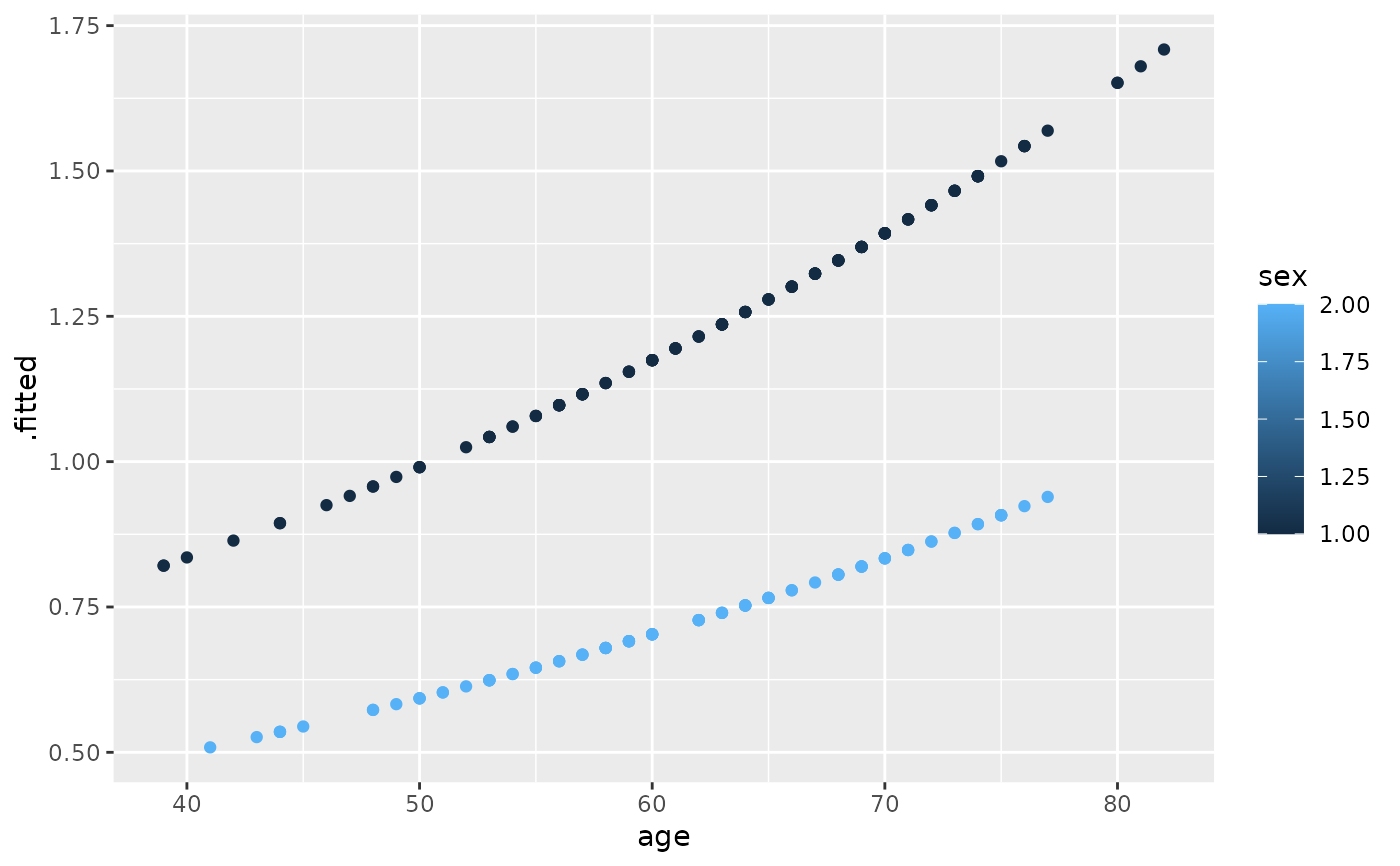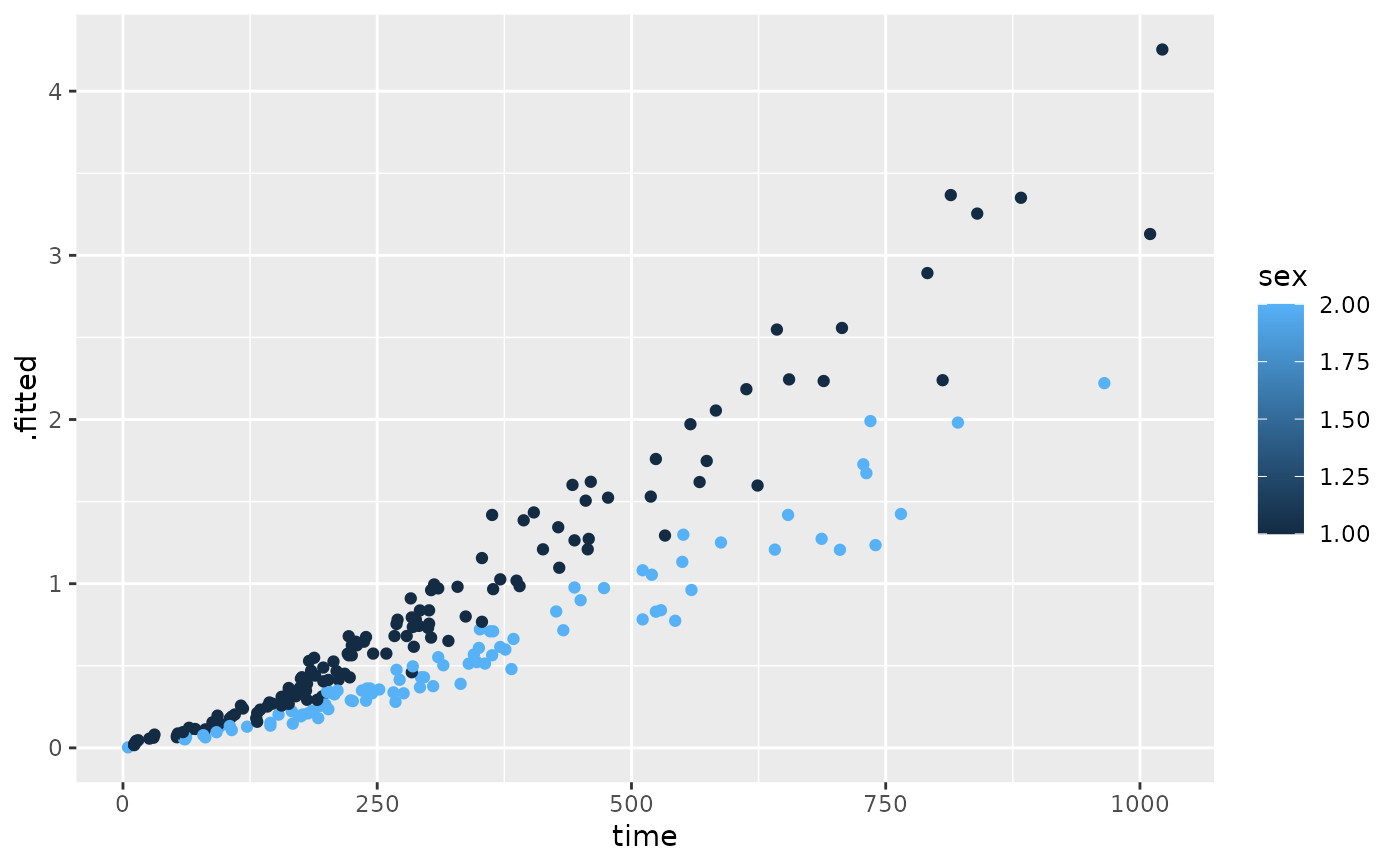Augment accepts a model object and a dataset and adds
information about each observation in the dataset. Most commonly, this
includes predicted values in the .fitted column, residuals in the
.resid column, and standard errors for the fitted values in a .se.fit
column. New columns always begin with a . prefix to avoid overwriting
columns in the original dataset.
Users may pass data to augment via either the data argument or the
newdata argument. If the user passes data to the data argument,
it must be exactly the data that was used to fit the model
object. Pass datasets to newdata to augment data that was not used
during model fitting. This still requires that at least all predictor
variable columns used to fit the model are present. If the original outcome
variable used to fit the model is not included in newdata, then no
.resid column will be included in the output.
Augment will often behave differently depending on whether data or
newdata is given. This is because there is often information
associated with training observations (such as influences or related)
measures that is not meaningfully defined for new observations.
For convenience, many augment methods provide default data arguments,
so that augment(fit) will return the augmented training data. In these
cases, augment tries to reconstruct the original data based on the model
object with varying degrees of success.
The augmented dataset is always returned as a tibble::tibble with the
same number of rows as the passed dataset. This means that the passed
data must be coercible to a tibble. If a predictor enters the model as part
of a matrix of covariates, such as when the model formula uses
splines::ns(), stats::poly(), or survival::Surv(), it is represented
as a matrix column.
We are in the process of defining behaviors for models fit with various
na.action arguments, but make no guarantees about behavior when data is
missing at this time.
Usage
# S3 method for class 'coxph'
augment(
x,
data = model.frame(x),
newdata = NULL,
type.predict = "lp",
type.residuals = "martingale",
...
)Arguments
- x
A
coxphobject returned fromsurvival::coxph().- data
A base::data.frame or
tibble::tibble()containing the original data that was used to produce the objectx. Defaults tostats::model.frame(x)so thataugment(my_fit)returns the augmented original data. Do not pass new data to thedataargument. Augment will report information such as influence and cooks distance for data passed to thedataargument. These measures are only defined for the original training data.- newdata
A
base::data.frame()ortibble::tibble()containing all the original predictors used to createx. Defaults toNULL, indicating that nothing has been passed tonewdata. Ifnewdatais specified, thedataargument will be ignored.- type.predict
Character indicating type of prediction to use. Passed to the
typeargument of thestats::predict()generic. Allowed arguments vary with model class, so be sure to read thepredict.my_classdocumentation.- type.residuals
Character indicating type of residuals to use. Passed to the
typeargument ofstats::residuals()generic. Allowed arguments vary with model class, so be sure to read theresiduals.my_classdocumentation.- ...
Additional arguments. Not used. Needed to match generic signature only. Cautionary note: Misspelled arguments will be absorbed in
..., where they will be ignored. If the misspelled argument has a default value, the default value will be used. For example, if you passconf.lvel = 0.9, all computation will proceed usingconf.level = 0.95. Two exceptions here are:
Details
When the modeling was performed with na.action = "na.omit"
(as is the typical default), rows with NA in the initial data are omitted
entirely from the augmented data frame. When the modeling was performed
with na.action = "na.exclude", one should provide the original data
as a second argument, at which point the augmented data will contain those
rows (typically with NAs in place of the new columns). If the original data
is not provided to augment() and na.action = "na.exclude", a
warning is raised and the incomplete rows are dropped.
See also
Other coxph tidiers:
glance.coxph(),
tidy.coxph()
Other survival tidiers:
augment.survreg(),
glance.aareg(),
glance.cch(),
glance.coxph(),
glance.pyears(),
glance.survdiff(),
glance.survexp(),
glance.survfit(),
glance.survreg(),
tidy.aareg(),
tidy.cch(),
tidy.coxph(),
tidy.pyears(),
tidy.survdiff(),
tidy.survexp(),
tidy.survfit(),
tidy.survreg()
Value
A tibble::tibble() with columns:
- .fitted
Fitted or predicted value.
- .resid
The difference between observed and fitted values.
- .se.fit
Standard errors of fitted values.
Examples
# load libraries for models and data
library(survival)
# fit model
cfit <- coxph(Surv(time, status) ~ age + sex, lung)
# summarize model fit with tidiers
tidy(cfit)
#> # A tibble: 2 × 5
#> term estimate std.error statistic p.value
#> <chr> <dbl> <dbl> <dbl> <dbl>
#> 1 age 0.0170 0.00922 1.85 0.0646
#> 2 sex -0.513 0.167 -3.06 0.00218
tidy(cfit, exponentiate = TRUE)
#> # A tibble: 2 × 5
#> term estimate std.error statistic p.value
#> <chr> <dbl> <dbl> <dbl> <dbl>
#> 1 age 1.02 0.00922 1.85 0.0646
#> 2 sex 0.599 0.167 -3.06 0.00218
lp <- augment(cfit, lung)
risks <- augment(cfit, lung, type.predict = "risk")
expected <- augment(cfit, lung, type.predict = "expected")
glance(cfit)
#> # A tibble: 1 × 18
#> n nevent statistic.log p.value.log statistic.sc p.value.sc
#> <int> <dbl> <dbl> <dbl> <dbl> <dbl>
#> 1 228 165 14.1 0.000857 13.7 0.00105
#> # ℹ 12 more variables: statistic.wald <dbl>, p.value.wald <dbl>,
#> # statistic.robust <dbl>, p.value.robust <dbl>, r.squared <dbl>,
#> # r.squared.max <dbl>, concordance <dbl>,
#> # std.error.concordance <dbl>, logLik <dbl>, AIC <dbl>, BIC <dbl>,
#> # nobs <dbl>
# also works on clogit models
resp <- levels(logan$occupation)
n <- nrow(logan)
indx <- rep(1:n, length(resp))
logan2 <- data.frame(
logan[indx, ],
id = indx,
tocc = factor(rep(resp, each = n))
)
logan2$case <- (logan2$occupation == logan2$tocc)
cl <- clogit(case ~ tocc + tocc:education + strata(id), logan2)
tidy(cl)
#> # A tibble: 9 × 5
#> term estimate std.error statistic p.value
#> <chr> <dbl> <dbl> <dbl> <dbl>
#> 1 toccfarm -1.90 1.38 -1.37 1.70e- 1
#> 2 toccoperatives 1.17 0.566 2.06 3.91e- 2
#> 3 toccprofessional -8.10 0.699 -11.6 4.45e-31
#> 4 toccsales -5.03 0.770 -6.53 6.54e-11
#> 5 tocccraftsmen:education -0.332 0.0569 -5.84 5.13e- 9
#> 6 toccfarm:education -0.370 0.116 -3.18 1.47e- 3
#> 7 toccoperatives:education -0.422 0.0584 -7.23 4.98e-13
#> 8 toccprofessional:education 0.278 0.0510 5.45 4.94e- 8
#> 9 toccsales:education NA 0 NA NA
glance(cl)
#> # A tibble: 1 × 18
#> n nevent statistic.log p.value.log statistic.sc p.value.sc
#> <int> <dbl> <dbl> <dbl> <dbl> <dbl>
#> 1 4190 838 666. 1.90e-138 682. 5.01e-142
#> # ℹ 12 more variables: statistic.wald <dbl>, p.value.wald <dbl>,
#> # statistic.robust <dbl>, p.value.robust <dbl>, r.squared <dbl>,
#> # r.squared.max <dbl>, concordance <dbl>,
#> # std.error.concordance <dbl>, logLik <dbl>, AIC <dbl>, BIC <dbl>,
#> # nobs <dbl>
library(ggplot2)
ggplot(lp, aes(age, .fitted, color = sex)) +
geom_point()
 ggplot(risks, aes(age, .fitted, color = sex)) +
geom_point()
ggplot(risks, aes(age, .fitted, color = sex)) +
geom_point()
 ggplot(expected, aes(time, .fitted, color = sex)) +
geom_point()
ggplot(expected, aes(time, .fitted, color = sex)) +
geom_point()

